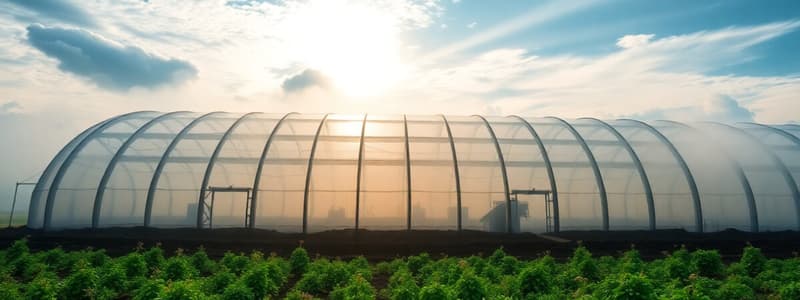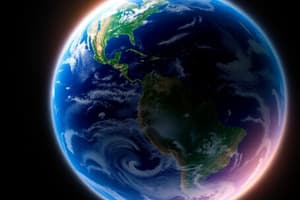Podcast
Questions and Answers
The layer of the atmosphere that is most crucial for weather phenomena is the ______.
The layer of the atmosphere that is most crucial for weather phenomena is the ______.
troposphere
The seasonal winds that reverse their direction according to the time of year are called ______ winds.
The seasonal winds that reverse their direction according to the time of year are called ______ winds.
monsoon
The process where the atmosphere traps longwave radiation, warming the Earth, is known as the ______ effect.
The process where the atmosphere traps longwave radiation, warming the Earth, is known as the ______ effect.
greenhouse
The permanent winds that blow from the subtropical high-pressure belts towards the equator are known as the ______.
The permanent winds that blow from the subtropical high-pressure belts towards the equator are known as the ______.
The condition of the atmosphere at a specific place and time is referred to as ______.
The condition of the atmosphere at a specific place and time is referred to as ______.
The force exerted by the weight of air above a given point is known as ______ pressure.
The force exerted by the weight of air above a given point is known as ______ pressure.
The layer of the atmosphere containing the ozone layer, which absorbs harmful UV radiation, is called the ______.
The layer of the atmosphere containing the ozone layer, which absorbs harmful UV radiation, is called the ______.
Winds that blow from high-pressure areas to low-pressure areas are caused by differences in ______.
Winds that blow from high-pressure areas to low-pressure areas are caused by differences in ______.
Flashcards
Composition of the Atmosphere
Composition of the Atmosphere
The atmosphere consists primarily of nitrogen and oxygen.
Permanent Winds
Permanent Winds
Winds that consistently blow in the same direction, like trade winds and westerlies.
Seasonal Winds
Seasonal Winds
Winds that change direction with the seasons, affecting weather patterns.
Local Winds
Local Winds
Signup and view all the flashcards
Greenhouse Effect Gas
Greenhouse Effect Gas
Signup and view all the flashcards
Air Pressure
Air Pressure
Signup and view all the flashcards
Types of Rainfall
Types of Rainfall
Signup and view all the flashcards
Wind
Wind
Signup and view all the flashcards
Study Notes
Air Composition
- The atmosphere is a mixture of gases, tiny dust particles, and other entities.
- Nitrogen makes up 78% of the atmosphere.
- Oxygen makes up 21% of the atmosphere.
- Argon makes up 0.93% of the atmosphere.
- Carbon dioxide makes up 0.03% of the atmosphere.
- Other gases make up 0.04% of the atmosphere.
Greenhouse Effect
- Carbon dioxide released into the atmosphere traps heat radiated from the Earth.
- This effect is called the greenhouse effect.
- Without the greenhouse effect, Earth's temperature would be too cold to support life.
- Increased levels of carbon dioxide, from sources like factory smoke and car fumes, intensifies heat retention.
- This leads to a rise in global temperature, called global warming
- Resulting in snow melt and sea-level increases, causing coastal flooding.
Layers of the Atmosphere
- The atmosphere is divided into five layers: Troposphere, Stratosphere, Mesosphere, Thermosphere, and Exosphere.
- Troposphere is the layer closest to Earth, and where weather phenomena like rain and hail occur.
- Stratosphere contains the ozone layer, shielding the Earth from harmful UV rays.
- Mesosphere is the layer where many meteors burn up.
- Thermosphere is a very hot layer, with temperatures increasing with altitude.
- Exosphere is the outermost layer, extending into space, and where the atmosphere thins out.
Weather and Climate
- Weather refers to the short-term conditions of the atmosphere, like temperature, humidity, and precipitation.
- Climate is the average weather condition of a place over a long period.
- Temperature is measured using a thermometer.
- Air pressure measures air's force and decreases with height.
- Insolation is the incoming solar energy.
- Winds are horizontal movement of air from high to low pressure areas.
Types of Rainfall
- Convectional rainfall occurs when the sun heats the Earth's surface, causing warm air to rise and cool.
- Orographic rainfall happens when moist air is forced to rise over a mountain.
- Cyclonic rainfall results from the air pressure changes associated with a cyclone.
Cyclones
- Cyclones are severe storms characterized by high winds, heavy rains, and a low-pressure center.
- Cyclones are especially common along India's eastern coast.
- Extreme winds, tidal surges, and heavy rains are main factors that cause damages during cyclones.
Moisture
- Water evaporates into water vapour.
- Moisture in the air measures humidity.
- Warmer air can hold more moisture.
- Condensation occurs when vapor cools and forms water droplets, leading to clouds and precipitation.
Studying That Suits You
Use AI to generate personalized quizzes and flashcards to suit your learning preferences.




